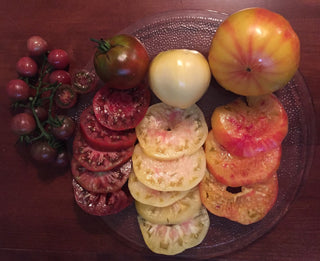Tomatoes are the royalty of the garden — and the kitchen. They're the country's most popular garden vegetable by a mile. This is probably because it's almost impossible to duplicate the juicy sweetness of a homegrown tomato.
However, tomatoes haven’t always been as well known and grown as they are now. Did you know that tomatoes are thought to have originated from South America around Peru and Ecuador? The name tomato comes from the Aztec word tomatl. The tomato was introduced to Europe in the early 1500s, becoming popular in Spain and Italy as a houseplant as it was considered poisonous. It was not for another couple hundred years that it became a staple in Italian cuisine, and this was only due to famine. The mighty tomato did not come to the United States until the late 1700s and was not become popular until the early 1900s!1 It was right around this time that the first BLT was printed in Good Housekeeping!2
Tomato plants can be grouped into two categories:
- Determinate varieties grow to a moderate height, produce a lot of fruit, and call it quits.
- Indeterminate varieties grow tall and keep on growing and producing tomatoes until they're killed by frost or disease.
Starting Tomatoes from Seed
Tomato plants are easy to start from seed. Start them indoors, six to eight weeks before you put them out into the garden. Under warm conditions indoors (70 degrees F.), the seeds will usually germinate in just a few days. Provide your tomato seedlings with 15 hours of bright light each day to keep them from getting leggy. You may need to transplant them into larger pots if they grow very quickly. Tomatoes are hungry plants and they need to be fertilized frequently, starting as seedlings.

Heirloom or Hybrid?
Because of the huge number of tomato plants out there, it's difficult to choose what to grow. If you're growing in less space, consider a dwarf variety. If you have more room, the options are incredible.
- Heirloom tomatoes are all the rage for their rich flavors, diverse colors and interesting shapes. They are not usually as productive as modern hybrids, and they tend to be a little fussier about growing conditions. That said, the flavors, shapes and colors are unrivaled.
- Hybrid tomato varieties are tasty, reliable and productive. They have also been bred for resistance to a few common tomato diseases. Unfortunately, you may find that even these disease-resistant varieties succumb to some of the same diseases that plague heirlooms. Most are fungal diseases that get established in the soil. It helps somewhat to mulch around your plants, and to avoid growing tomatoes in the same place every year.
Support Matters
Always provide some sort of support for your tomatoes. Letting them flop on the ground increases disease problems. Get your supports in place at planting time and make a habit of checking weekly to tie, prune or tuck-in wayward branches.
Tomato Growing FAQs
1. Do tomatoes come back every year?
No, tomatoes are annual and die with the frost. You should re-grow and re-plant new tomatoes every year. Volunteer tomatoes may pop up in your compost or along the edge or your garden when the seeds from last year’s crop were dispersed by wind or animals.3
2. I just planted my first tomato, when can I expect to see fruit?
Anywhere from 60-90 days after being planted outside.4 If you are looking to grow tomatoes fast, indeterminate tomatoes are faster to fruit.
3. How much should I be watering my tomato plants?
You should water your tomato plants to the depth of 6 inches.5 To be successful water the base of your plant slowly so the water penetrates deep into the roots. Underwatered tomatoes look dry and crackly. Overwatered tomatoes have yellowing and wilting leaves. Unfortunately, drooping leaves is a sign of over AND underwatering, which means you may have to do more investigating as to whether your plants need more or less water.
4. What is the best soil for tomatoes?
Sandy loam! However, tomatoes can thrive in most soil types except clay.6 Curious about what type of soil you have? Check out our DIY Soil Test.
Sources
1 Tomato | Description, Cultivation, & History | Britannica
3 Should I Keep My Volunteer Tomatoes: Weeding Out Or Growing Volunteer Tomatoes | Gardening Know How
4 How Long Do Tomato Plants Take to Grow - Back Gardener
5 Watering Tomato Plants - How To, How Often & How Much - Tomato Bible





